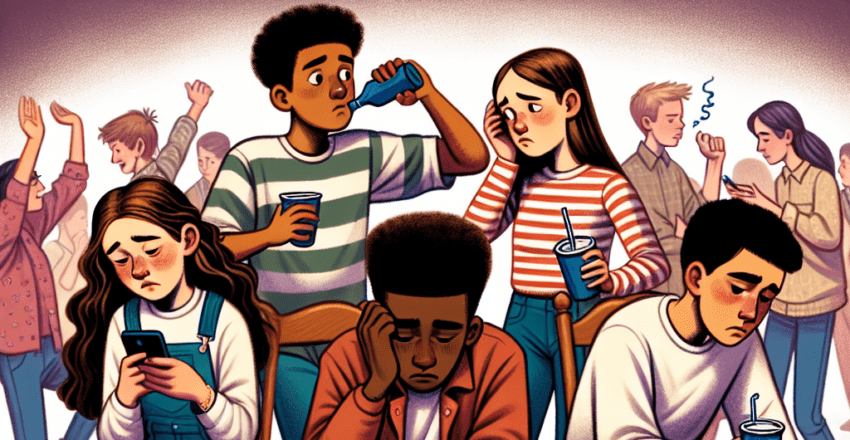What Is Digital Addiction?
Digital addiction happens when someone spends excessive time on their phone, computer, social media, or gaming to the point where it interferes with real-life responsibilities and relationships. It’s not always obvious—one moment, you’re just checking a notification, and before you know it, hours have slipped away. While technology makes life easier and more entertaining, overuse has led to a growing issue: dependency on digital devices.
How Is It Affecting the Young Generation?
In today’s world, young people are more connected than ever. A study by the Department of Research & Evaluation found that excessive screen time is linked to a 30% increase in anxiety and depression among young people. (Source)
Constant exposure to digital media impacts mental well-being, leading to sleep disorders, stress, and even social isolation—despite being “connected” all the time.
Social media plays a huge role. Apps like Instagram, TikTok, and Snapchat are designed to keep users engaged for hours. Gaming is another major factor, offering entertainment and an escape from reality. These platforms are built to trigger dopamine (the brain’s “feel-good” chemical), similar to gambling, making users crave constant engagement and validation. Unlike past generations, today’s youth seek approval through likes, comments, and shares instead of face-to-face interactions.
Academic and Cognitive Impacts
Excessive digital consumption also affects focus and productivity. With notifications constantly pulling attention away, students struggle to concentrate, leading to poor academic performance. Multitasking between screens and tasks reduces cognitive efficiency and memory retention over time.
Digital Addiction’s Effect on Physical & Mental Health
The consequences of digital addiction aren’t just mental—they impact physical health too. Here’s how:
Physical Health Impacts
- Eye Strain and Vision Issues: Prolonged screen use leads to dry eyes, headaches, and even an increase in myopia, especially among children.
- Posture Problems & Musculoskeletal Pain: Sitting for long periods in poor positions leads to neck, back, and wrist pain, a common issue among gamers and office workers.
- Hearing Damage: Excessive headphone use at high volumes can cause long-term hearing damage. A UK gamer reportedly suffered permanent hearing loss due to playing with headphones for six hours daily(source).
- Obesity & Metabolic Issues: A sedentary lifestyle, fueled by excessive screen time, increases the risk of obesity and diabetes, as confirmed by studies from the Centers for Disease Control and Prevention (CDC).
- Sleep Disruptions: Exposure to blue light from screens before bed disrupts melatonin production, affecting sleep quality and contributing to insomnia.
Mental Health Impacts
- Depression & Anxiety: High social media use is linked to increased anxiety and depression, as young users compare themselves to idealized online versions of others.
- Addiction & Gaming Disorder: The World Health Organization classifies Gaming Disorder as a mental health condition, where excessive gaming interferes with daily life and responsibilities.
- Reduced Attention Span: Constant digital engagement, especially with fast-paced content, makes it harder for young people to focus for extended periods.
- Social Isolation: In the past, kids spent more time outdoors, playing and interacting in person. Today, many prefer digital interactions, leading to increased social anxiety and a decline in face-to-face communication skills.
Final Thoughts
Digital addiction is real, and its effects on the younger generation are significant. While technology is an essential part of modern life, it’s important to maintain a balance. Parents, educators, and young people themselves must take steps to create healthier digital habits—setting screen time limits, prioritizing offline activities, and making mindful choices about how they engage with technology. The key is moderation: technology should be a tool, not a trap.
Avoiding digital addiction isn’t about quitting technology but creating balance. Start by setting screen time limits using built-in features like “Screen Time” on iPhones or “Digital Wellbeing” on Android. Taking regular breaks—just 5–10 minutes every hour—helps prevent eye strain and mindless scrolling. Creating tech-free zones, especially in the bedroom or at the dining table, improves relationships and sleep quality.
Prioritizing real-world interactions is key—meeting friends, engaging in hobbies, or spending time outdoors reduces screen dependency. Turning off non-essential notifications helps minimize distractions while replacing digital habits with offline activities like reading, exercising, or creative hobbies brings more fulfilment. Before picking up your phone, ask yourself: Do I need to do this? Being mindful of tech use allows young people to stay connected without being controlled by their devices.

